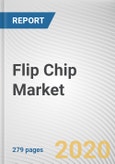The growth of the global flip chip market is majorly driven by rise in need for circuit miniaturization, rise in trend in Internet of Things (IoT), and technological superiority over wire bonding. However, huge initial investment required for setting up new manufacturing facility and less options for customization are the restraints associated with flip chip, which hamper market growth. Moreover, surge in demand for sensors in smartphone industry and increase in integration of flip chip in personal electronic devices such as PCs and mobiles are expected to offer lucrative opportunities for the market.
The global flip chip market is segmented on the basis of flip chip packaging technology, bumping technology, industry, and region. On the basis of bumping technology, the market is divided into copper pillar, solder bumping, gold bumping, and others, including aluminum & conductive polymer bumping. The copper pillar segment dominates the market, as it is a next-generation flip chip interconnect, which meet current and future electronic device requirements. It serves as an ideal interconnect option for applications such as transceivers, embedded processors, and electrical processors.
On the basis of packaging technology, the market is categorized into 3D IC, 2.5D IC, and 2D IC. Among these, the 2.5D IC packaging segment dominated the market in 2019 owing to its several advantages such as superior capacity, improved performance, and minimal system space requirements, and low power consumption. Depending on industry, the market is fragmented into electronics, industrial, automotive & transport, healthcare, IT & telecommunication, aerospace & defense, and others. Region wise, it is analyzed across North America, Europe, Asia-Pacific, and LAMEA.
The market players operating in the flip chip market include IBM Corporation, Intel Corporation, Fujitsu Ltd., 3M, Samsung electronics Co., Ltd, Amkor Packaging Technology, Inc., TSMC, Ltd, Apple, Inc., Texas Instruments, Inc., and AMD, Inc. These major players have adopted various key development strategies such as business expansion, and new product launch, which help them to strengthen their foothold in the market.
KEY BENEFITS FOR STAKEHOLDERS
- The study provides an in-depth analysis of the current & future trends of the market to elucidate the imminent investment pockets.
- Information about key drivers, restraints, and opportunities and their impact analysis on the global flip chip market share is provided.
- Porter’s five forces analysis illustrates the potency of buyers and suppliers operating in the global flip chip industry.
- The quantitative analysis of the market from 2019 to 2027 is provided to determine the global flip chip market potential.
KEY MARKET SEGMENTS
By Packaging Technology
- 3D IC
- 2.5D IC
- 2D IC
By Bumping Technology
- Copper Pillar
- Solder Bumping
- Gold Bumping
- Others (Aluminum & Conductive Polymer)
By Industry
- Electronics
- Industrial
- Automotive & Transport
- Healthcare
- IT & Telecommunication
- Aerospace & Defense
- Others
By Region
- North America
- U.S.
- Canada
- Europe
- Germany
- France
- UK
- Rest of Europe
- Asia-Pacific
- Japan
- China
- India
- Rest of Asia-Pacific
- LAMEA
- Latin America
- Middle East
- Africa
Key Market Players
- 3M
- Advanced Micro Devices, Inc.
- Amkor Technology
- Apple Inc.
- Fujitsu Limited
- Intel Corporation
- International Business Machines Corporation
- Samsung Electronics Co., Ltd.
- Taiwan Semiconductor Manufacturing Company Limited
- Texas Instruments Incorporated
Table of Contents
Companies Mentioned
- 3M
- Advanced Micro Devices Inc
- Amkor Technology
- Apple Inc
- Fujitsu Limited
- Intel Corporation
- International Business Machines Corporation
- Samsung Electronics Co Ltd
- Taiwan Semiconductor Manufacturing Company Limited
- Texas Instruments Incorporated
Methodology
The analyst offers exhaustive research and analysis based on a wide variety of factual inputs, which largely include interviews with industry participants, reliable statistics, and regional intelligence. The in-house industry experts play an instrumental role in designing analytic tools and models, tailored to the requirements of a particular industry segment. The primary research efforts include reaching out participants through mail, tele-conversations, referrals, professional networks, and face-to-face interactions.
They are also in professional corporate relations with various companies that allow them greater flexibility for reaching out to industry participants and commentators for interviews and discussions.
They also refer to a broad array of industry sources for their secondary research, which typically include; however, not limited to:
- Company SEC filings, annual reports, company websites, broker & financial reports, and investor presentations for competitive scenario and shape of the industry
- Scientific and technical writings for product information and related preemptions
- Regional government and statistical databases for macro analysis
- Authentic news articles and other related releases for market evaluation
- Internal and external proprietary databases, key market indicators, and relevant press releases for market estimates and forecast
Furthermore, the accuracy of the data will be analyzed and validated by conducting additional primaries with various industry experts and KOLs. They also provide robust post-sales support to clients.

LOADING...








